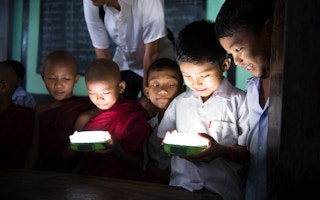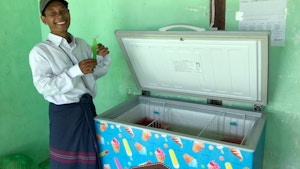Being able to keep busy in the evenings or receive medical treatment at night are among the things that people who live in areas with ready energy access never think twice about—but they pose a huge challenge to those who live off the grid, where the modern convenience of lighting and electricity are out of reach.
The latter is true for people such as San San Myint, a midwife from Myanmar, who had to care for pregnant women in the two villages where she works under the glow of kerosene lamps once the sun had set.
But the situation changed in 2013 when residents received solar lanterns under a programme organised by Japanese electronics company Panasonic and its local partner, the non-governmental organisation (NGO) Save the Children Japan.
“There were many difficulties in providing healthcare at night,” said Myint in a social impact survey report for Panasonic’s 100 Thousand Solar Lanterns Project. “Now solar lanterns help us a lot in our daily activities. We can also use them for emergency situations, as [we live in] a high-risk area for natural disasters.”
For populations for whom electricity and lighting at night is a distant reality, kerosene lamps are the next best way for them to continue activities at night. However, these lamps provide little illumination and strain the eyes, while purchasing kerosene fuel takes up money that could be otherwise used in better ways, such as food or education for families. Smoke produced from burning the fuel is also harmful to respiratory systems.
Worldwide 1.1 billion people do not have connection to their national power grids, which has serious consequences for their ability to break out of the poverty cycle. For instance, children from homes with no light are unable to finish their homework at night, making it difficult for them to advance in their lessons and find well-paying jobs in future.
The good news is electrification in Asia Pacific has come a long way. China became fully electrified in 2014, while countries such as Nepal, Cambodia and India have achieved some of the highest rates in electrification growth, according to a 2017 report by the United Nations Economic and Social Commission for Asia and the Pacific.
But the same report found that the rate of electrification has since slowed due to population growth in rural areas and the challenges involved in electrifying these regions. With rising carbon emissions in the atmosphere driving the threat of climate change, how countries provide energy to their people is critical for sustainable development in the region.
Salt and solar
Electrification is an especially complicated challenge when it comes to providing energy to island dwellers, who cannot be quickly or easily connected to mainland power stations. This is an understatement for countries like the Philippines, which is made up of more than 7,000 islands and hard-to-reach indigenous communities who rely on kerosene lamps for illumination.
It is with these people in mind that Filipina scientist Aisa Mijeno invented the Sustainable Alternative Lighting (SALt) lamp in 2015. The contraption generates electricity using saltwater.
The electricity generated can be used to charge a mobile phone or light an LED bulb for eight hours to provide a sustainable form of energy for people living off-grid.
Today the social enterprise continues to produce SALt lamps and runs campaigns on its website canvassing for donations in order to provide lamps to indigenous communities.
Multinational corporations are also proving they can be a force for good. In the case of Panasonic, it started with a letter from a Ugandan minister to Panasonic in 2006, asking that the Japanese firm find a way to use its solar technology to help the African nation deliver electricity to its people. This request later morphed into Panasonic’s corporate social responsibility project known as 100 Thousand Solar Lanterns Project, in which Panasonic pledged to deliver 100,000 solar-powered lamps to off-grid populations by 2018, the 100th anniversary of the company’s founding.
And deliver it did. By 2018, the Japanese company had donated 102,716 solar lanterns to 30 countries in Asia and Africa in partnership with more than 131 organisations. In Myanmar, where the project was first launched, Panasonic has donated 14,924 solar lamps in five years.
Each solar lantern came with a solar panel and a lamp equipped with a battery that can emit light for between six and 90 hours, depending on the amount of solar charge it receives during the day and the brightness of the lamp.
Speaking to Eco-Business, a Panasonic spokesperson recognised that the solar lanterns were only the first step to establishing long-term energy access for the communities it had worked with. “By providing light to these countries, the basic needs of the people can be improved significantly,” he said. “For instance, lighting assists medical treatment or allows studying at night.”
In Cambodia, the introduction of solar lamps has halved the monthly fuel costs for families, and roughly 2,434 babies were born in solar lamp light between 2015 and 2017 in Myanmar as a result of the project.
And it’s not only those on the receiving end who are benefiting; Panasonic’s spokesperson says the positive response from the donations is the validation needed for the electronics giant to commercialise its solar lanterns business, which is now underway.





















